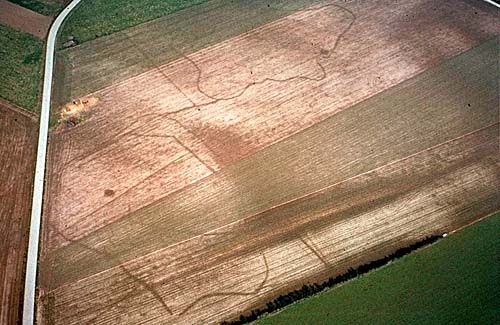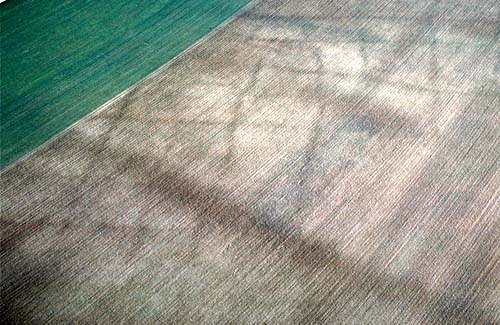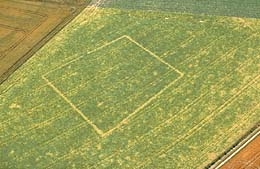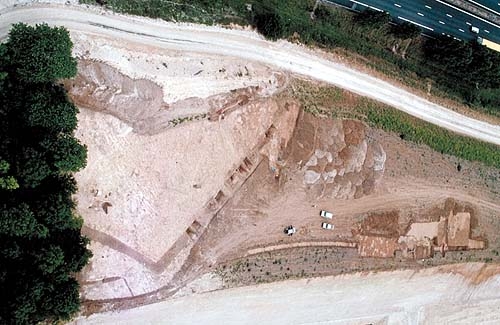- Home
- Discoveries
- Gallic settlements
- Large, simple and festive enclosures
Large curved system without filled-in pits. This is probably a simple agricultural or livestock enclosure. Bacouël-sur-Selle (Somme)
Aerial prospecting has revealed the presence of large, non-nested enclosures that are delimited by a single ditch. Excavations of these areas have almost never produced archaeological remains. In addition, there are no filled-in pits either inside or outside the enclosure. These are probably enclosures of cultivated land, designed to protect the crops from wild and domestic animals. It also seems that they are sometimes used to enclose livestock. At their entrances, excavations have revealed the presence of postholes and sometimes palisades that appear to be designed to facilitate the passage of herds of animals to be penned up.
"Celtic fields" and other parcels of land
There are also multiple enclosures that are placed next to each other. At Prouzel (Somme), we find straight-sided, irregular, quadrangular plots, the so-called "Celtic fields". Before the invention of the moldboard plow, whose blade turned over the earth, farmers used an ard, or scratch-plow, which only opened the soil. To turn the soil completely, it was necessary to plow a field crosswise as well, which led to the formation of nearly square fields in order to facilitate the work of plowing. Although these types of plots are well known in the British Isles, it is rarely seen in Picardy. Nevertheless, the widespread and important excavations led by D. Bayard (1996) recently revealed complex plots of land in use at the beginning of the Roman era between Le Translay and Bouillancourt-en-Séry (Somme).
Large curved enclosures, isolated and surrounded by a single ditch at Quesnoy-sur-Airaines (Somme).
Different levels of dampness in the soil makes these quadrangular, so-called "Celtic" fields to appear at Prouzel (Somme).
Festive enclosures
Recently, J. L. Brunaux (2000) has demonstrated the symbolic function of all types of enclosures, even apparently utilitarian ones. This is obvious for the small ritual and funerary enclosures — it was necessary to separate the world of the living from that of the dead. It is also true for the large enclosures for dwellings, since the enclosure was a symbol of ownership and therefore exclusion. J.L. Brunaux has shown that the infrequent regularity of the large enclosures is an indicator that they belonged to the aristocracy.
Certain geometric enclosures could define "festive spaces" that were used for hospitality rituals of the Gallic nobility, with banquets and libations, as material discovered in filled-in pits seems to indicate. Among other things, these have revealed a number of fragments of amphoras imported from distant places. Some of these quadrangular geometric enclosures also contained necropoli, with or without sanctuaries.
This very regular enclosure could be that of a festive space or a Gallic necropolis. La Chaussée-Tirancourt (Somme).
An exceptional site — which was the object of a rescue archaeology campaign — along the path where a high-speed train line crossed the Aronde River. Montmartin (Oise).
The case of Montmartin (Oise)
This is a rich aristocratic habitation from the third and second century BCE, which was excavated and published by J. L. Brunaux (1996) It features several enclosures subdividing the space into hierarchical sections. The central enclosure is the most regular and the most carefully tended. A public and cultural space was found here, along with a small temple. A large adjoining space disclosed traces of complex practices such as the preparation of corpses. In warrior society of the Gauls, religious rites were always present. The archaeological finds were particularly abundant, revealing — among other things — the presence of craft activities (pottery production, metallurgy, etc.).





